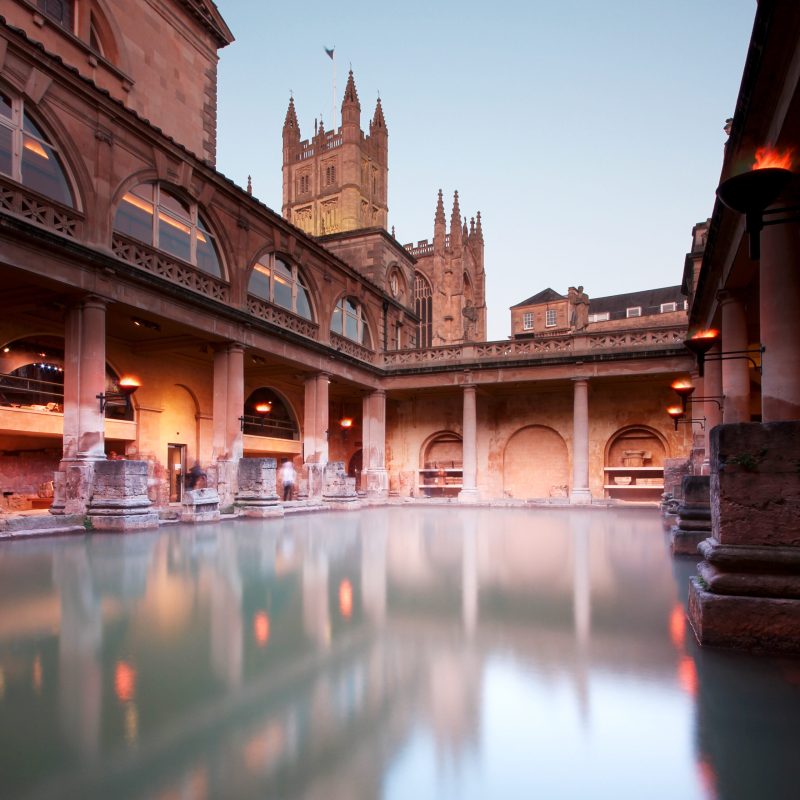
Visitors to Bath are transported back to a time when horse-drawn carriages were the primary form of transportation and community-wide dances were the highlight of the week. For a while, this was the home of the famous British writer Jane Austen, who published six major novels on themes of friendship and romance.
Videos by TravelAwaits
But while Austen is a beloved part of Bath’s history, she is just a very small part of the city’s story. Bath is layered with history, beginning with King Lear’s father, Prince Bladud, who was supposedly cured of leprosy by the waters there in 860 B.C. The city’s curative waters have been attracting visitors ever since.
With its lovely parks, charming cobblestone streets, and iconic architecture, Bath is an ideal destination for couples looking for a romantic getaway. Here are some of the best ways to spend a weekend in the city.

Soak In The Thermal Waters
More than 2,000 years after the hot springs were discovered in Bath, the legendary waters are still the city’s top attraction. Today, visitors can combine a visit to a modern spa with a dip in the famous thermal waters at Thermae Bath Spa. This spa offers amazing views from its rooftop pool. Taking a soak with a glass of prosecco in hand is a truly romantic experience.
Another option for enjoying the thermal waters is to visit the Gainsborough Bath Spa nearby. Located in a five-star hotel, this facility is smaller than and not as well known as Thermae Bath Spa, but it can be a nice alternative for couples looking for more privacy. Hotel guests receive complimentary access during designated hours.
Over the years, Bath has developed an impressive collection of spas offering a wide array of facilities, treatments, and wellness classes. The Visit Bath website offers a complete list.

Explore Ancient Roman Ruins
After “taking the waters,” it’s time to see how the Romans relaxed. The Roman Baths is a must-see attraction in town, but its name doesn’t do justice to all that took place there, or all that can be seen by visitors today.
Between A.D. 60 and 70 a Roman temple was built on the site, which then attracted a surrounding urban development called Aquae Sulis. Over the next 300 years, the bathing complex was developed. Archeologists believe that the baths were just a small part of what was once a major wellness facility for Roman men and women. There were rooms adjoining the baths for massages and large outdoor courts for games.
The Romans continued to use the baths until the fifth century, but with disuse, they fell into ruin. However, the baths were redeveloped a few times starting in the 12th century. The most recent redevelopment took place in the 1800s, when the Grand Pump Room was added. This was a place where visitors could drink the waters.
A ticket to the Roman Baths includes access to the museum and an audio guide. The museum houses extensive exhibits about the site and the artifacts discovered during its excavation. You should set aside at least 2 hours to completely experience this attraction. Near the exit, be sure to try a sip of the hot springs water!

Stroll The Charming Streets
The City of Bath was designated a UNESCO World Heritage site in 1987. The Roman Baths played a critical role in that designation, but equally important were the city’s well-preserved examples of 18th-century architecture. Visitors can stroll for miles along cobblestone streets lined with beautiful Georgian houses surrounding green lawns and gardens. At times, you’ll feel like you’re walking through the set of a BBC television series!
To learn more about the history of the city, take a free walking tour with the Mayor of Bath’s Corps of Honorary Guides. Long-time Bath residents lead these tours and share their knowledge of the city’s history, culture, and architecture.

Travel Back In Time To The Days Of Jane Austen
Jane Austen lived in Bath for just six years; nevertheless, she is the city’s biggest celebrity, and her fans will not be disappointed when visiting. The Jane Austen Centre offers exhibits about her life with a focus on her time in Bath. The Centre also includes a gift shop and tea room.
A Jane Austen Festival is held each year for 10 days in September. Festival activities include a Regency costume parade, dances, games, and lectures.
Finally, you can walk in Austen’s footsteps on a free self-guided audio tour provided by Visit Bath. This 1.5-hour tour includes excerpts from Austen’s novels and letters that describe Bath as it would have been in its Georgian heyday.

Sip Afternoon Tea In A Historic Setting
Afternoon tea can be enjoyed anywhere in England, but there is something especially romantic about it in Bath. The tradition of afternoon tea began in the mid-1800s, which coincides nicely with the heyday of Bath. This is when the town played a major role in the British social scene, and afternoon tea became part of the circuit of must-attend functions.
Many places offer tea in a historic setting, but one of the most popular places to experience the tradition is the Grand Pump Room, located next to the Roman Baths. While the pump room originally served as a place for patrons to drink the thermal waters, food service was eventually provided. Today, afternoon tea is offered daily along with a full menu.
No. 15 Great Pulteney offers another delicious option. Located in a beautifully preserved Georgian townhouse, this afternoon tea is all about the classics: clotted cream and scones served alongside dainty sandwiches.
Finally, the Royal Crescent Hotel offers a tasty afternoon tea along with lovely views of the park. This five-star hotel is located in the architecturally renowned Royal Crescent building.

Admire The Glorious Abbey
In the heart of the city is Bath Abbey, founded in the seventh century. Originally a Benedictine monastery, the abbey was later appropriated by the Church of England. As a result of fires, the structure had to be rebuilt twice, and today’s building is an excellent example of Perpendicular Gothic architecture. Due to the large number and size of the windows, the interior is surprisingly bright.
Those looking for a great view of Bath’s city center should consider climbing the 212 steps of the abbey’s tower. The abbey is still an active place of worship, but visitors are permitted to enter, and tours are available.

Appreciate The Georgian Architecture
Bath is known for its phenomenal Georgian architecture. Two of the best examples are the Royal Crescent and the nearby Circus.
Considered one of the greatest examples of Georgian architecture in Britain, the Royal Crescent was designed by John Wood the Younger and built between 1767 and 1774. This was home to many of Britain’s wealthiest and most notable citizens.
The Circus is a circle of townhomes divided into three parts and surrounding a park. It was designed by John Wood the Elder and built between 1754 and 1768. While not as prestigious as the Royal Crescent, the Circus also housed famous residents, including the painter Sir Thomas Gainsborough.
Both of these sites are easily accessible on foot. Consider taking a free walking tour to learn more.

Relax In Royal Victoria Park
Located very near the Royal Crescent, Royal Victoria Park spans 57 acres and is home to tree-lined paths, beautiful botanic gardens, and even a duck pond. It was established by the 11-year-old Princess Victoria seven years before she ascended to the throne.
This is a lovely place to stroll with your partner, enjoy a picnic, and appreciate the view. But if more activity is your style, the park also offers tennis, bowling, a putting green, and a golf course.
Take A Balloon Ride
While strolling through Royal Victoria Park, you might notice hot-air balloons floating high in the sky. Weather permitting, this is an excellent way to see Bath and a romantic way to end your time in the city. Balloon rides take place at dawn or dusk and include a glass of champagne. For an hour, you’ll enjoy all of Bath’s top sights from above.
Want to visit more of England’s smaller cities? Here are some of the best.
